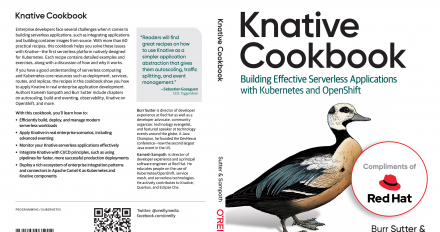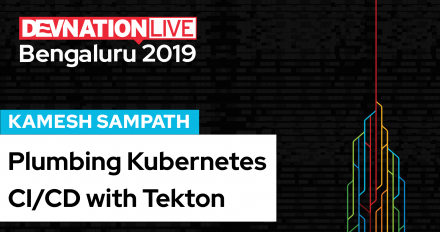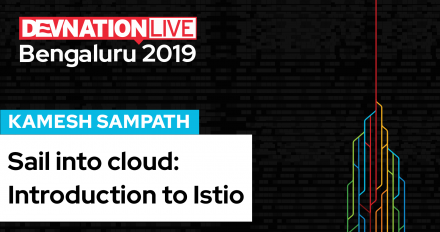
Director of Developer Experience at Red Hat
Kamesh Sampath
Kamesh is a Principal Software Engineer at Red Hat as part of his additional role as Director of Developer Experience at Red Hat. Kamesh has been a contributor to open source projects for more than a decade, and he is now actively involved in open source projects like Knative, Minikube, Eclipse Che, Quarkus, and Apache Camel K. As part of his developer philosophy he strongly believes in LEARN MORE, DO MORE, and SHARE MORE!
Blog: https://developers.redhat.com/blog/author/kameshsampath/
Kamesh Sampath's contributions

Article
Knative Cookbook: Building Effective Serverless Applications with Kubernetes and OpenShift
Kamesh Sampath
+1
Use serverless architecture with Kubernetes, explore practical applications, and follow how-to scenarios through the "Knative Cookbook" from O'Reilly.

Article
Cloud-native integration with Kubernetes and Camel K
editorial-team
+1
Kamesh Sampath shows how to apply common Enterprise Integration Patterns (EIP) with Apache Camel, Kubernetes, and Red Hat OpenShift.

Article
Plumbing Kubernetes CI/CD with Tekton
editorial-team
+1
Learn how to combine various building blocks of Tekton to build and deploy a cloud-native application.

Article
Video: Introduction to Istio service mesh
Kamesh Sampath
Kamesh Sampath provides an overview of Envoy and Istio, two open source projects that will change the way you write cloud-native Java applications on Kubernetes. We’ll show how to download and set up Istio on your local laptop, then deploy Java microservices as part of the Istio service mesh with Istio sidecar proxy.

Article
DevNation Live Bengaluru: Sail into cloud — An introduction to Istio
editorial-team
+1
Kamesh Sampath shows how to download and set up Istio on your local laptop, then deploy Java microservices as part of the Istio service mesh.

Article
Deploying an internal container registry with Minikube add-ons
Kamesh Sampath
We show how to use Minikube's registry add-on to deploy an internal registry, which can be used to push and pull Linux container images.

Article
Build your Kubernetes armory with Minikube, Kail, and Kubens
Kamesh Sampath
To increase your productivity as a Kubernetes app developer, you need to be armed with the right set of tools such as Minikube, Kail, and Kubens.

Article
Init Container Build Pattern: Knative build with plain old Kubernetes deployment
Kamesh Sampath
Solve common Kubernetes deployment issues using the Init Container build pattern and Knative build, which can be applied to any Kubernetes deployment.

Knative Cookbook: Building Effective Serverless Applications with Kubernetes and OpenShift
Use serverless architecture with Kubernetes, explore practical applications, and follow how-to scenarios through the "Knative Cookbook" from O'Reilly.

Cloud-native integration with Kubernetes and Camel K
Kamesh Sampath shows how to apply common Enterprise Integration Patterns (EIP) with Apache Camel, Kubernetes, and Red Hat OpenShift.

Plumbing Kubernetes CI/CD with Tekton
Learn how to combine various building blocks of Tekton to build and deploy a cloud-native application.

Video: Introduction to Istio service mesh
Kamesh Sampath provides an overview of Envoy and Istio, two open source projects that will change the way you write cloud-native Java applications on Kubernetes. We’ll show how to download and set up Istio on your local laptop, then deploy Java microservices as part of the Istio service mesh with Istio sidecar proxy.

DevNation Live Bengaluru: Sail into cloud — An introduction to Istio
Kamesh Sampath shows how to download and set up Istio on your local laptop, then deploy Java microservices as part of the Istio service mesh.

Deploying an internal container registry with Minikube add-ons
We show how to use Minikube's registry add-on to deploy an internal registry, which can be used to push and pull Linux container images.

Build your Kubernetes armory with Minikube, Kail, and Kubens
To increase your productivity as a Kubernetes app developer, you need to be armed with the right set of tools such as Minikube, Kail, and Kubens.

Init Container Build Pattern: Knative build with plain old Kubernetes deployment
Solve common Kubernetes deployment issues using the Init Container build pattern and Knative build, which can be applied to any Kubernetes deployment.
